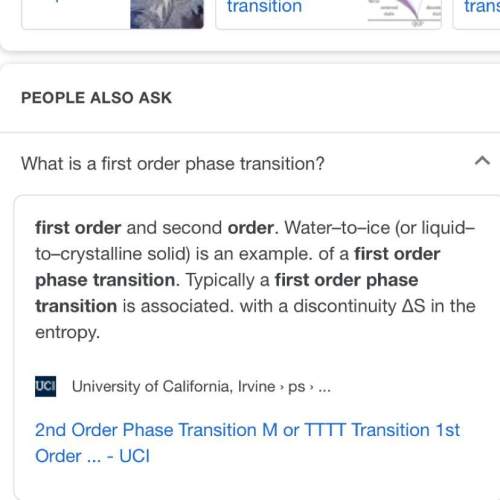
Physics, 04.05.2021 17:10 genyjoannerubiera
SOS NEED HELP ASAP
In lab you burned 2.0 grams of peanuts. After burning the peanut 1.05 grams remained(did not burn). The 75ml of water in the calorimeter increased from 22 degrees Celsius to 91 degrees Celsius. Solve for
The mass of the peanut burned in the reaction,
The energy gained in joules by the water,
The Joules per Gram of the food that was burned
The Calories per gram of the food, (note: 1calorie=4.184Joules and 1000calories= 1 Calorie or check your notes and see what we did in lab)
Bonus Point: calculate the percent error. The package says that there are 2.5 serving, 170 Calories per serving, and there is a total of 71g of peanuts.
(Percent error is the Calories per gram found in part d minus the Calories per gram found in the package then divide that number by the Calories per gram in the package. Finally multiple times 100.

Answers: 1
Another question on Physics

Physics, 22.06.2019 06:20
Clothing made of several thin layers of fabric with trapped air in between, often called ski clothing, is commonly used in cold climates because it is light, fashionable, and a very effective thermal insulator. so it is no surprise that such clothing has largely replaced thickand heavy old-fashioned coats. (a) consider a jacket made of five layers of 0.1-mm-thick synthetic fabric (k = 0.13 w/m·°c) with 1.5-mm-thick air space (k = 0.026 w/m·°c) between the layers. assuming the inner surface temperature of the jacket to be 28°c and the surface area to be 1.25 m2, determine the rate of heat loss through the jacket when the temperature of the outdoors is 0°c and the heat transfer coefficient at the outer surface is 25 w/m2·°c. (b) what would your response be if the jacket is made of a single layer of 0.5-mm-thick synthetic fabric? what should be the thickness of a wool fabric (k = 0.035 w/m·°c) if the person is to achieve the same level of thermal comfort wearing a thick wool coat instead of a five-layer ski jacket?
Answers: 1

Physics, 22.06.2019 15:40
Question 1 what is amperage? is the rate of doing work. is the rate of flow of protons in electric current. represents the amount of pressure behind electron flow. is the rate of flow of electrons in electric current. 2 points question 2 what is voltage? is the rate of doing power. represents the amount of pressure behind electron flow. is the rate of doing work. is the rate of flow of electrons in electric current. 2 points question 3 what is power? is the rate of flow of protons in electric current. is the rate of flow of electrons in electric current. is the rate of doing work. represents the amount of pressure behind electron flow. 2 points question 4 if we multiply volts times amps we get what? power circuit work current 2 points question 5 what are two ways alternating currents are similiar? in both ac and dc electrons flow in the same pattern. in both ac and dc, the flow of electrons changes directions back and forth. both ac and dc are only possible in certain materials with atoms that will allow electron flow. both ac and dc involve the flow of electrons. 4 points question 6 how does the flow of electrons flow in an alternating current? the flow of electrons is always slower in an alternating current than within a direct current. the flow of electrons is not constant and forward; it changes direction back and forth. electrons flow from from a higher affinity to that of a lower affinity. electron flow is constant and only in a forward direction. 2 points question 7 what is the flow like in a direct current? the flow of electrons is not constant and forward; it changes direction back and forth. the flow of electrons is constant and only in a forward direction. the flow of electrons go from a higher affinity to a lower affinity. the flow of electrons are always faster in a direct current. 2 points question 8 how is an electric current able to flow? electrons flow from the higher affinity to lower affinity and electrical current is generated. protons flow from the higher affinity to lower affinity and electrical current is generated. the movement of protons from one atom to another leads to an electric charge. the movement of electrons from one atom to another atom in a line results in a flow of electric current. 2 points question 9 how do electrons move from the two different types of metal in a battery? protons flow from the metal with the lower affinity to the metal with higher affinity and electrical current is generated. electrons flow from the metal with the lower affinity to the metal with higher affinity and electrical current is generated. electrons flow from the metal with the higher affinity to the metal with lower affinity and electrical current is generated. protons flow from the metal with the higher affinity to the metal with lower affinity and electrical current is generated.
Answers: 2

Physics, 22.06.2019 16:00
What part of the ear is names after tools, such as the hammer and the anvil?
Answers: 1

Physics, 22.06.2019 17:40
Aball is thrown horizontally from a cliff at 8m/s .in what direction is the ball moving 2s later?
Answers: 1
You know the right answer?
SOS NEED HELP ASAP
In lab you burned 2.0 grams of peanuts. After burning the peanut 1.05 grams rem...
Questions





Geography, 06.04.2020 23:21










Mathematics, 06.04.2020 23:21


Mathematics, 06.04.2020 23:21







